Using the Camera node¶
Use the Camera node to show the content of a Scene in Kanzi Studio Preview and in your Kanzi application.
In the Kanzi Studio Preview, you see a Scene through the Camera node that is set as the preview camera of that Scene node. Turning a Camera node into a preview camera.
Do not scale a Camera node, or its ancestor nodes, using the Render Transformation or Layout Transformation property. When you scale a Camera node, you affect the projection so that it does not match the parameters that you set.
Setting the position of a Camera node¶
To set the position of a Camera node:
In the Preview, select the Camera tool.
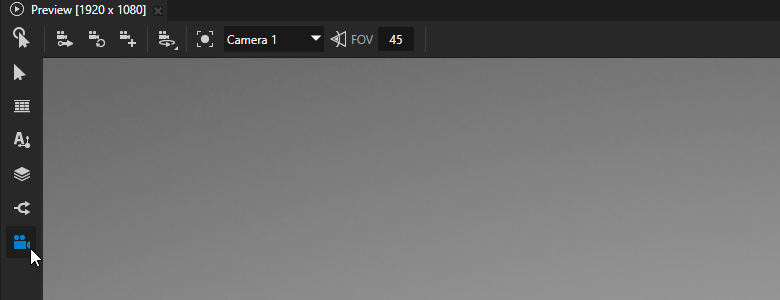
In the Camera tool, you can select the Orbit Camera or Free Camera:


Orbit Camera lets you move around:
The nodes that you select in the Node Tree.
The node that you set with the Constraints > Look At property of the camera.
To move with the orbit camera, use these controls:
Control
Description
Click and drag the left mouse button.
Rotate
Click and drag the middle mouse button.
Press the Space key, and click and drag the left mouse button.
Pan
Scroll the mouse wheel.
Press the Shift and Alt keys, and click and drag the left mouse button.
Zoom
Hold down Ctrl and click the left mouse button.
Select or deselect a 3D node.

Free Camera lets you move around without attachment to any point.
To move with the free camera, use these controls:
Control
Description
W
Move forward.
Hold down Shift to double the speed.
S
Move backward.
Hold down Shift to double the speed.
A
Move left.
Hold down Shift to double the speed.
D
Move right.
Hold down Shift to double the speed.
Q
Tilt left.
E
Tilt right.
Click and drag the left mouse button.
Rotate
Click and drag the middle mouse button.
Pan
Scroll the mouse wheel.
Set camera speed.
Scroll down to decrease the camera speed.
Scroll up to increase the camera speed.
Hold down Ctrl and click the left mouse button.
Select or deselect a 3D node.
When setting the position of a Camera node, use these controls:
Control
Description

Store the current position of the camera to the preview Camera node.

Reset the camera to the current position of the preview Camera node.

Create a new Camera node from the current position of the camera.

Bring the camera to the 3D object selected in the Node Tree or the Preview.

Select the Camera node through which you want to view the current scene.

Set the field of view for the camera in degrees when working with 3D nodes.
Tip
To access the Camera tool when you use the Node tool, press the Alt key. The camera type depends on the type selected in the Camera tool.
Turning a Camera node into a preview camera¶
In the Kanzi Studio Preview, you see a Scene through the Camera node that is set as the preview camera of that Scene node. By default, the Preview uses the default camera of the Scene.
To turn a Camera node into a preview camera, in the Node Tree either:
Double-click that Camera node.
Right-click that Camera node and select Activate Camera in Preview.
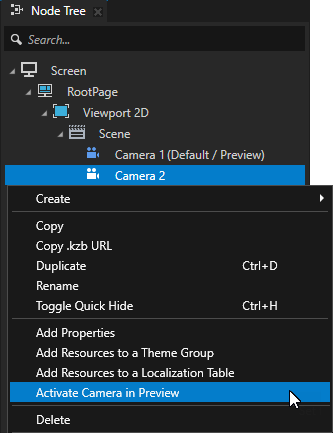
When you set the preview camera, Kanzi Studio:
In the Scene node, sets the Preview Camera property to the Camera node that you turned into the preview camera.
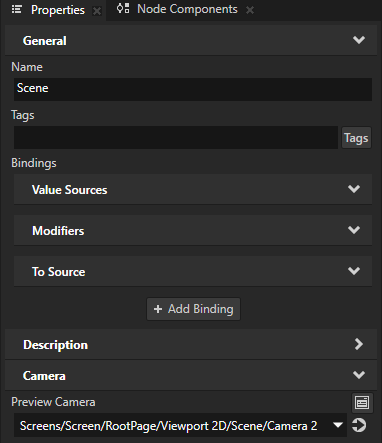
In the Node Tree, marks the preview camera with (Preview).
Keep in mind that your Kanzi application uses the camera that is set in the Scene node with the Camera property. In the Node Tree, Kanzi Studio marks this camera with (Default).
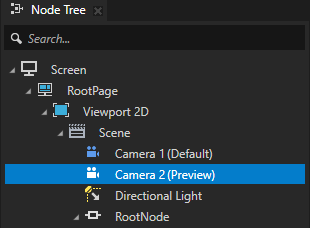
Viewing the active Scene from the preset viewpoints¶
The Camera tool allows you to quickly view the content of an entire Scene from one of the preset viewpoints: front, back, top, bottom, left, or right side. Unless you switch on the option to store the current position of the camera ( ), the preset viewpoints do not change the position of the Camera nodes in a Scene. See Setting the position of a Camera node.
), the preset viewpoints do not change the position of the Camera nodes in a Scene. See Setting the position of a Camera node.
To view the entire active Scene from a preset viewpoint:
In the Preview, select the Camera tool.

Use these default shortcuts:
Preset viewpoint
Default shortcut
Shortcut description
View a scene from the left.
Shift 1
Left Camera Preset
View a scene from the right.
Shift 2
Right Camera Preset
View a scene from the top.
Shift 3
Top Camera Preset
View a scene from the bottom.
Shift 4
Bottom Camera Preset
View a scene from the front.
Shift 5
Front Camera Preset
View a scene from the back.
Shift 6
Back Camera Preset
To set your own shortcut keys, in the main menu, select Edit > User Preferences and there select the Shortcut Keys tab.
Creating a Camera node¶
In the Node Tree or Prefabs, you can create a Camera node in a Scene node or any 3D node.
To create a Camera node in the Preview:
In the Preview, select the Camera tool.

Use either the Orbit Camera or Free Camera to move to the location where you want to create a camera. See Setting the position of a Camera node.
Click
 .
.
Kanzi Studio creates a Camera node in the position of the camera.
Setting the projection type of a Camera node¶
3D projection makes it possible to display 3D objects on a 2D surface.
These projection types are available in Kanzi:
Perspective projection shows objects closer to the camera larger than those that are further away. This is the default projection type. See Perspective projection.
Asymmetric perspective projection lets you control the field of view of each angle of a perspective projection. See Asymmetric perspective projection.
Orthographic projection shows a 2D view of a 3D scene without providing a sense of depth. See Orthographic projection.
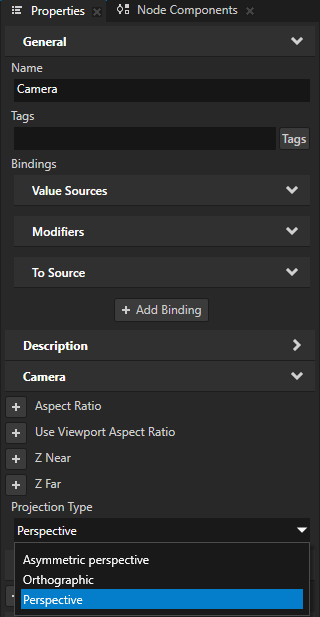
Perspective projection¶
Use perspective projection to provide a realistic view of a 3D scene. Perspective projection sets a camera to show objects closer to the Camera node larger than those that are further away. This is the projection type most commonly used for 3D scenes, and the default projection type in Kanzi.
To use perspective projection:
Select a Camera node.
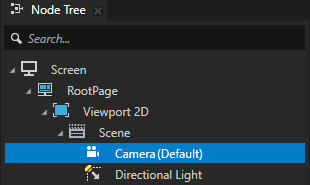
In the Properties, add and set:
(Optional) Projection Type to Perspective.
This is the default value.
FOV Type to set the direction of the field of view:
X FOV sets the field of view along the x axis.
Y FOV sets the field of view along the y axis. This is the default.
FOV to set the field of view of the camera in degrees.
The default is 45 degrees.
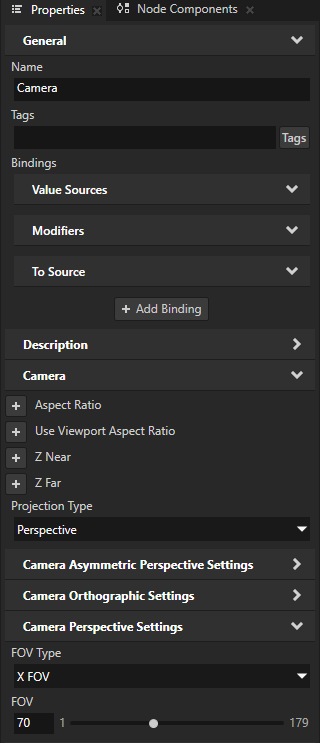
Asymmetric perspective projection¶
Use asymmetric perspective projection when you want to control the field of view of perspective projection separately toward the left, right, up, and down.
To use asymmetric perspective projection:
Select a Camera node.

In the Properties, add and set:
Projection Type to Asymmetric perspective
Asymmetric FOV to the field of view toward the left, right, up, and down in degrees.
By default, the field of view extends 45 degrees to the left, right, up, and down.
For example, to match a perspective projection with the default 45-degree field of view along the y axis, set the Asymmetric FOV property:
Up property field to -22.5
Down property field to 22.5
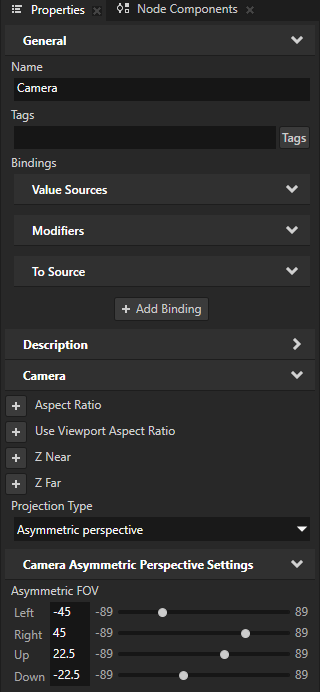
Orthographic projection¶
Use orthographic projection to show a 2D view of a 3D scene without providing a sense of depth. The orthographic projection lines are orthogonal to the projection plane, and the distance from the camera does not affect the drawing size of objects.
To use orthographic projection:
Select a Camera node.

In the Properties, add and set:
Projection Type to Orthographic
Orthogonal Type to the type of orthogonal coordinate system that you want to use:
Absolute sets the camera to display an area whose size matches the size of the parent Viewport 2D node in pixels.
Relative sets the camera to display an area whose width is scaled with the value of the Orthogonal Plane Size property. This is the default.
Orthogonal Plane Size to set the half width or half height of the view plane of a camera that uses the Relative coordinate system:
When FOV Type is set to Y FOV (default value), Orthogonal Plane Size sets the height of the view plane.
When FOV Type is set to X FOV, Orthogonal Plane Size sets the width of the view plane.
The default value is 1.0.
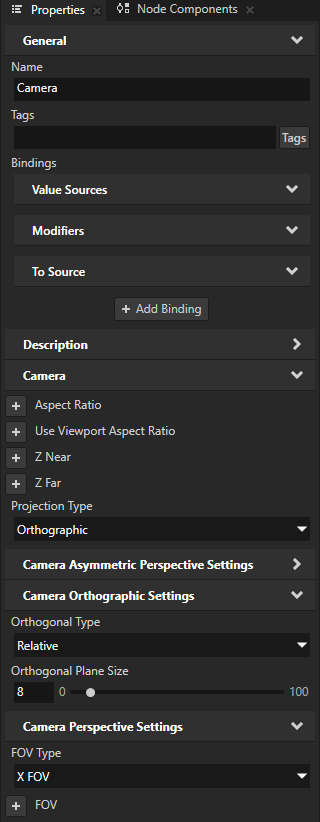
Setting the camera for render passes¶
When you use render passes to define the rendering of 3D content, you can set in each render pass the Camera node that the render pass and its descendants use to render content. See Rendering.
By default, render passes use the default Camera node in a Scene node to render content. In any render pass, you can add and set the Draw Object Render Pass > Camera property. This way, you set the render pass and its descendant render passes to use a specific camera. The value of the Draw Object Render Pass > Camera property set in a render pass overrides the value that you set in an ancestor render pass.
For example, in this render pass prefab, all Draw Object Render Pass render passes by default use the Camera node set in the Camera property of the Scene node. If you in the Group Render Pass add and set the Draw Object Render Pass > Camera property, all render passes in that render pass prefab use that camera, unless you set their Camera property.


The Draw Object Render Pass calculates the values of these properties from the property values of the Camera and passes them to shaders:
Calculated Camera Matrix sets the
kzCameraMatrixuniform.Calculated Camera Position sets the
kzCameraPositionuniform.Calculated Homogeneous View Position sets the
kzViewPositionuniform.Calculated Projection Matrix sets the
kzProjectionMatrixuniform.Calculated Projection Near And Far Planes sets the
kzCameraNearFarPlaneuniform.
See Shader uniforms.
You can set these properties in a render pass. The values that you set override the property values that you set in the Camera node.
Using the Camera node in the API¶
To create a camera with an orthographic projection:
// Create a camera named Camera.
CameraSharedPtr camera = Camera::create(domain, "Camera");
// Set the projection of the camera to relative orthogonal.
camera->setOrthogonalProjection(Camera::OrthogonalCoordinateSystemRelative);
// Make the viewing box display [-width,width] x [-1, 1] x [-1, 1] portion of the 3D space.
// The width of the viewing box is determined by the viewport aspect ratio.
camera->setOrthogonalPlaneHeight(1.0f);
camera->setZNear(-1.0f);
camera->setZFar(1.0f);
To create a camera with a perspective projection:
// Create a camera named Camera.
CameraSharedPtr camera = Camera::create(domain, "Camera");
// Set the projection of the camera to perspective.
camera->setPerspectiveProjection();
// Make the viewing box display a horizontal 90 degree cone of the 3D space.
// The vertical cone angle is determined by the viewport aspect ratio.
camera->setFovType(Matrix4x4::FieldOfViewType::YFov);
camera->setFov(90.0f);
camera->setZNear(0.1f);
camera->setZFar(100.0f);
For details, see the Camera class.
Camera property types and messages¶
For a list of the available property types and messages for the Camera node, see Camera.
See also¶
Making nodes turn to a Camera node